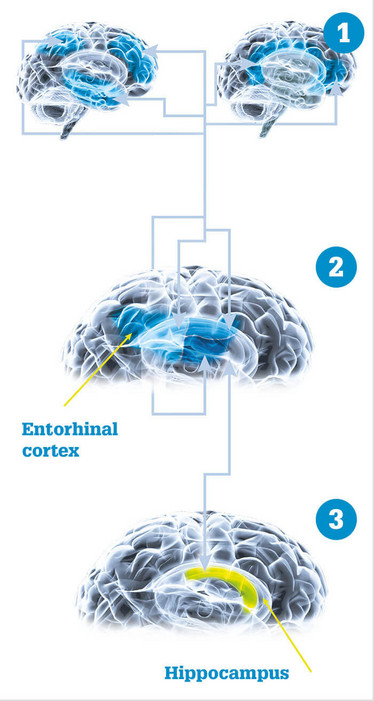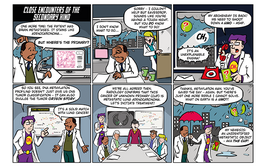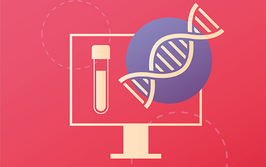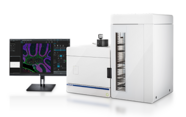Untangling Tau
As a neurologist, Bradley Hyman has seen first-hand the impact of Alzheimer’s disease on patients and their families. His lab examines the genetic and neuropathophysiological factors that play a part in the disease, and recently discovered a rare pathological form of the tau protein, which may hold the key to how Alzheimer’s spreads through the brain.

Alzheimer’s disease is a truly dreadful illness, but on a scientific level it is a fascinating one. The whole field of behavioral neurology – studying brain–behavior relationships – has learnt a great deal from these patients. Specifically, the way that people lose function during the course of the disease has taught us much about how the brain works, and raised many intriguing questions (many of which remain unanswered). An Alzheimer’s patient can remember in crystal-clear detail something that happened a decade ago, but can be completely unable to recall what happened three minutes ago. Patients often lose very specific aspects of cognitive function (for example, their ability to do sums or understand language) while seemingly more complex faculties remain entirely intact. We are now starting to understand exactly why and how this happens.
The Hippocampus and Memory

- Your experience and events of your life are represented in large-scale networks in your brain.
- The entorhinal cortex is the conduit for the formation of episodic memories by the hippocampus.
- The entorhinal cortex and hippocampus are early sites of Alzheimer's pathology and degeneration of neurons, coinciding with the signature symptomatic feature of Alzheimer’s, in which episodic memory impairment worsens.
The past decade has seen an extraordinary series of breakthroughs. We have mapped at least a dozen genes that clearly impact the relative risk of Alzheimer’s disease, although we understand the mechanisms of action of just three of them. When I started out as a neurologist, we could only diagnose Alzheimer’s disease post mortem. Now we can use spinal taps to test for biomarkers or PET scans to look directly at the brain, and diagnose patients while they are alive. We have a much better handle on the biochemistry and molecular biology of the lesions visible in the brain, and we now know that there is more to the story than what we can see through the microscope. We have also come to appreciate just how long the pre-symptomatic phase of the disease is – around 15 years.
But there’s still a lot we don’t know. Some patients deteriorate dramatically over three or four years, while others decline very little over 20 years. We know a lot about how amyloid builds up and forms plaques, but we don’t know what triggers progression from mild cognitive impairment to dementia. And we don’t know how to prevent it.
There is a mountain to climb – but it is not insurmountable. We recently made a discovery that may shed light on how the disease progresses at a molecular level (1). Neurofibrillary tangles made up of an abnormal form of the tau protein are one of the hallmarks of Alzheimer’s disease, disrupting the cellular microbtubule network and eventually killing neurons. They accumulate in a unique subset of neurons, spreading through the brain in a very distinct, hierarchical pattern, which maps to a stereotypical pattern of clinical symptoms. The hippocampus and entorhinal cortex – areas of the brain involved in memory formation – are the first areas affected, causing the typical early symptoms of forgetfulness or short-term memory problems. Then as the tangles spread into other parts of the brain, disturbances in language, spatial orientation and judgement start to appear. Our study was an attempt to understand the underlying biology of that progression. Neurons that develop tangles tend to be anatomically connected to each other, but the precise mechanisms behind this spread have been unclear. Mounting evidence suggests that tangles propagate via the transport of abnormal tau from an affected neuron to its neighbors. Once inside a healthy cell, abnormal tau can induce other tau molecules to assume the same pathologic form – like a prion. We have now identified a very rare form of tau that we believe is behind the propagation of abnormal tau between neurons.
We isolated various forms of tau from mouse and human brains, with and without Alzheimer’s disease, and screened for the properties we hypothesized would be necessary for propagation between neurons. Eventually, we found a very rare species of tau which fit all the criteria. Normal tau is an unfolded protein with only a few phosphorylation sites and a molecular weight of 40K. The species we detected had many more phosphorylation sites, a molecular weight of 500K and a specific structure not found in normal tau. We also found that abnormal tau was transmitted along the axons to neighboring neurons.
It appears that this rare subset of tau could play a pivotal role in progression of the disease. If we could block the transport of abnormal tau between neurons, it could be a way to slow progression. The next step is to find out what makes this rare form of tau so unique and what aspects allow its uptake, transport and release. Neurons often create misfolded proteins under normal circumstances, but the abnormal proteins are usually picked up and rapidly degraded by specialized pathways. Why this form of tau escapes that process is a deep mystery. If we can find the answer, we might be in a position to intervene and shift that equilibrium, even a little, back towards degradation. Given how long it takes for the disease to develop, a small shift might be sufficient. After all, cutting your cholesterol by just 10 percent is enough to delay heart disease. We now have the tools to diagnose Alzheimer’s disease at an early stage or even pre-symptomatically. If we could halt propagation between neurons at the first whisper of the illness, before it starts to cause symptoms, the hope is that we could stop the spread of tangles and hence the progression to dementia.
Bradley Hyman is Director, Massachusetts Alzheimer’s Disease Research Center, Co-Director, MGH Memory Disorders Unit and John B. Penney Jr. Professor of Neurology, Harvard Medical School, USA.
Iron’s Influence by James Connor
The Overactive Brain by Michela Gallagher
Food for Thought by Ewan McNay
- S. Takeda et al., “Neuronal uptake and propagation of a rare phosphorylated high-molecular-weight tau derived from Alzheimer’s disease brain”, Nat. Comm. 6, 8490 (2015). PMID: 26458742.
Bradley Hyman is Director, Massachusetts Alzheimer’s Disease Research Center, Co-Director, MGH Memory Disorders Unit and John B. Penney Jr. Professor of Neurology, Harvard Medical School, USA.




















